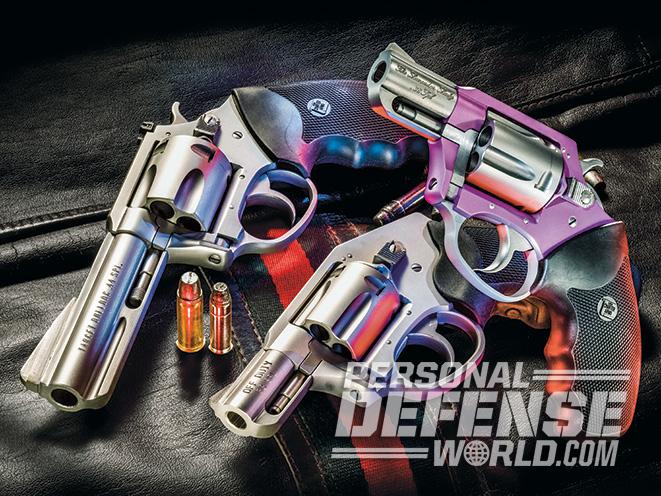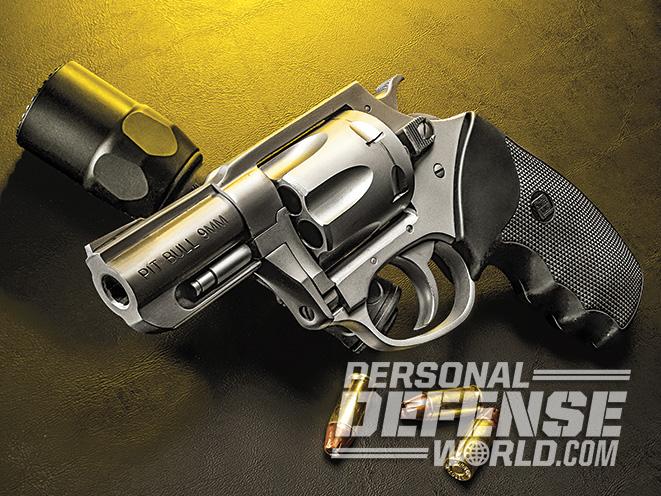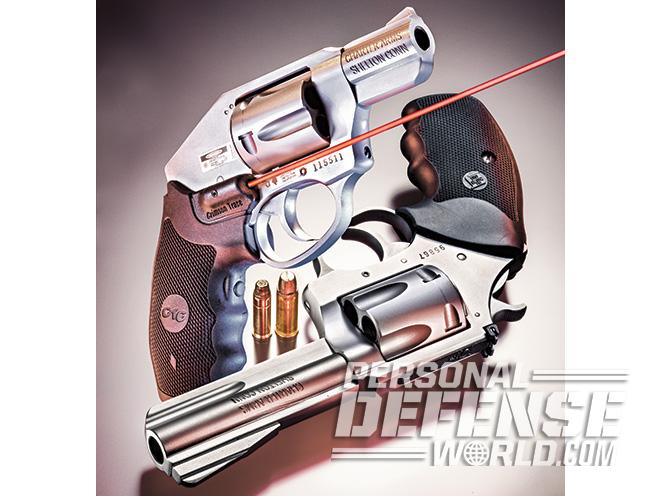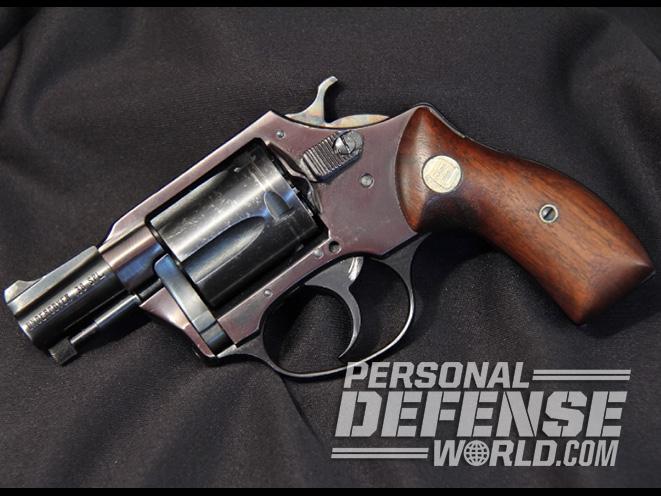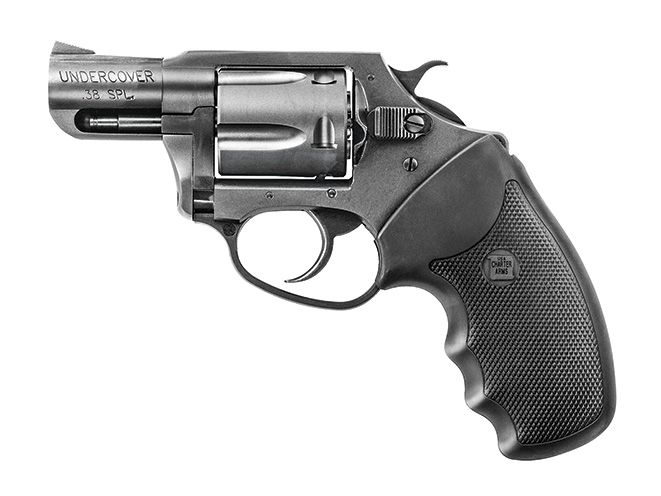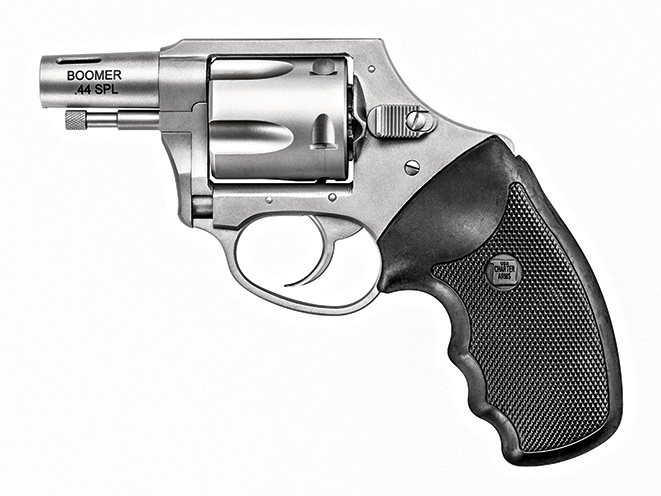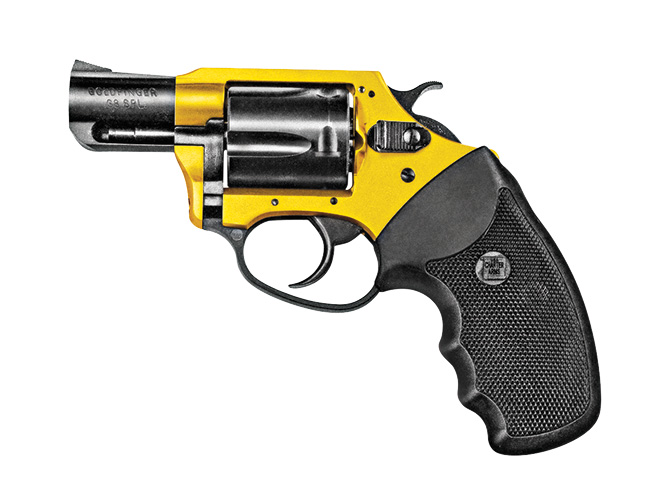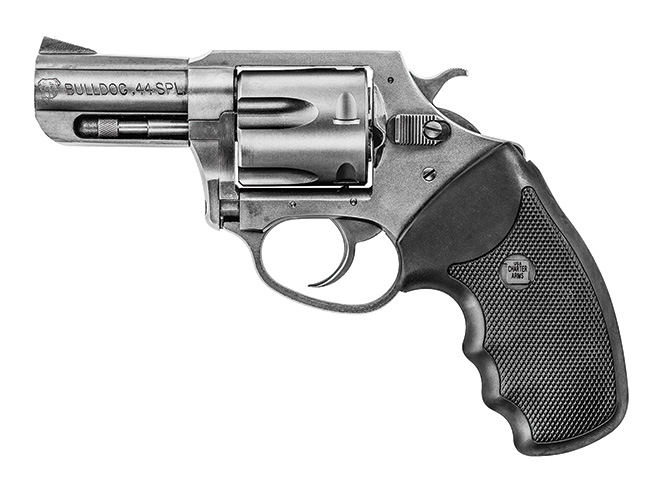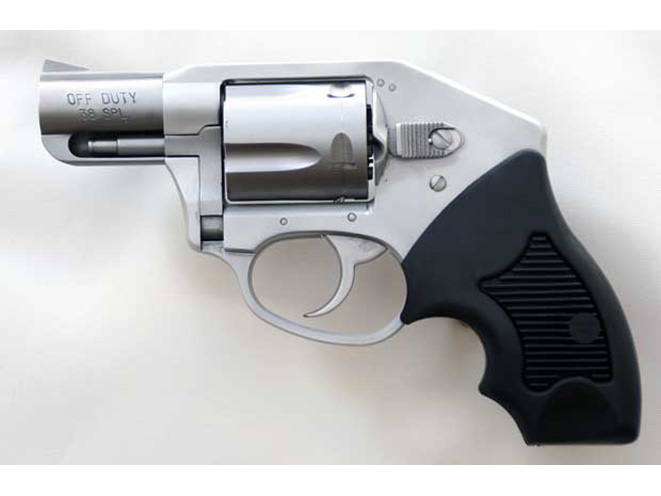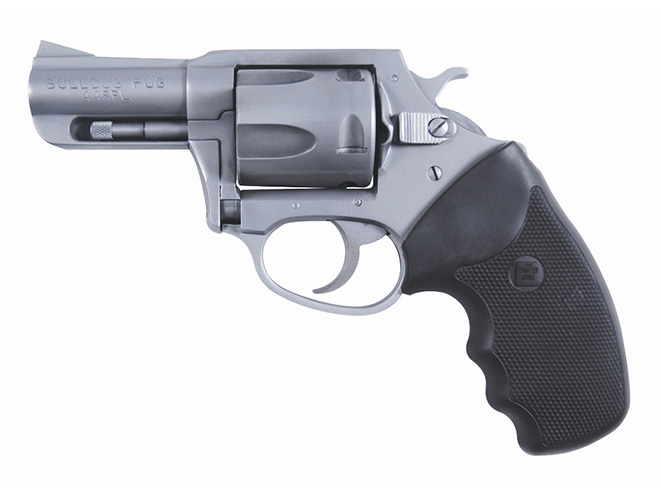Charter Arms has been around since 1964. The very first Charter Arms product was a five-shot, double-action, snub-nose revolver in .38 Special called the Undercover. It was conceived by American engineers who wanted a new and different handgun design while keeping with the traditions established in New England’s “Gun Valley.” At the time, this revolver was very different from the wheelguns produced by Colt and Smith & Wesson.
For starters, the frame was a solid piece of steel, which provided added strength. Unlike conventional revolvers, there was no sideplate; access to the action was through the bottom of the frame. All internal parts were attached by screws or pins, plus all the springs were coil springs. The grip frame/triggerguard was a one-piece unit made of aluminum alloy, which kept the weight of the gun down to 16 ounces and which permitted Charter Arms to advertise it as the lightest steel-framed revolver on the market. By comparison, the S&W Chief’s Special weighed 19 ounces and was roughly the same size.
Better Backup
Advertisement — Continue Reading Below

Colt and S&W centerfire revolvers at the time had their firing pins riveted in the hammer nose. Charter Arms, however, fitted the firing pin of the Undercover in the frame. It was spring-loaded and made of tough beryllium copper, making it almost unbreakable. The action itself had fewer major moving parts than its competitors, plus it had a shorter hammer throw, making the lock time faster. Both the trigger and the hammer spur were wider for easier user manipulation.
RELATED STORY: Swamp King – The Charter Arms Gator Revolver
The Undercover also used a hammer-block, transfer-bar safety system invented by Charter that only allowed the gun to fire when the trigger was fully to the rear. The cylinder locked in three different places instead of just two—at the breech face and on both sides of the frame using the ejector rod collar. It was also the only American revolver that didn’t have a cylinder stop in the frame to hold the cylinder in place when it was open for loading. Finally, the machined barrel had eight-groove rifling instead of six-groove, which improved the bullet seal and resulted in higher velocities and better accuracy potential.
Advertisement — Continue Reading Below
Initially, the Undercover was sold with a polished blue finish and smooth walnut grips that held a silver Charter Arms medallion. The Undercover was also made available with a nickel finish and a 3-inch barrel as time went on. In the 1965 edition of Gun Digest, S&W’s Chief Special was listed at $65, a Colt Detective Special was $69.50 and the Charter Arms Undercover was quoted as $55. Fifty years ago, a $10 savings could make a big difference. Quality-wise, the Charter was right up there with other American handgun makers.

I had an Undercover that I bought in the mid-1970s, and as I recall the fit and finish was on par with a square-butt Chief that I also owned at the time. I used this Undercover as a backup gun. Stoked with 110-grain JHP .38 Special loads, it rode in an ankle holster on my left leg. Back in the day, some police departments issued female officers revolvers chambered for the milder-shooting .32 S&W Long cartridge. To capture some of that market, Charter Arms introduced the Undercoverette. This was basically the same gun as the Undercover, but it had a six-shot cylinder bored to take the .32 S&W Long and .32 S&W cartridges.
RELATED STORY: Charter Arms’ New Pitbull Revolver in .45 ACP
Advertisement — Continue Reading Below
One of Charter Arms’ most well known revolvers is the Bulldog in .44 Special. This wheelgun, introduced in 1973, was designed to be a big-bore concealment piece, and it quickly became very popular. It looked much like the Undercover on steroids and had a 3-inch, tapered barrel, a five-shot cylinder and oversized, checkered walnut grips. Finish options on the Bulldog were polished blue or nickel. The .44 Bulldog came along about the same time as the Dirty Harry movie craze, and as a result lots of cops that could were carrying .44 Mag revolvers like the Charter .44 Bulldog as backup and off-duty guns.
The decade of the 1970s also saw Charter Arms introduce the Pathfinder revolver. Like the Undercover, it was based on a small frame and had a six-shot cylinder chambered for the .22 LR cartridge. Initially, it had a 3-inch, tapered barrel, but unlike the aforementioned Charter revolvers, it had a fully adjustable rear sight. It could be had with standard walnut service grips or oversized grips, and eventually a 6-inch-barreled version was offered. Later, it was chambered for .22 WMR, and for a time a .22 LR conversion cylinder was also available.
Snubbie Upgrades
Advertisement — Continue Reading Below

Today there are 13 models of Charter Arms revolvers, including the Undercover, Undercover Lite, Undercoverette, Bulldog, Pathfinder, Chic Lady, Southpaw, Pitbull, Mag Pug, Police Undercover, Police Bulldog, On Duty and Off Duty. Within these lines there are some 75 versions or variations.
All but a few of Charter Arms’ designs now have barrels with a shrouded ejector rod housing. This protects the ejector rod and adds just a little weight out front to improve balance. The barrels also have a rib on top with an integral front ramp sight. With a couple of exceptions, the Charter revolvers also now have oversized rubber combat grips. They are black neoprene with finger grooves and checkered panels on the sides. The concealed-hammer Off Duty has slightly smaller black rubber grips. All the Charter revolvers have a universal grip frame and all factory-made grips are interchangeable. Another option is to have a factory-fitted Crimson Trace Lasergrip installed, though they can also be ordered separately.
RELATED STORY: 11 Charter Arms Bulldog Revolvers
Advertisement — Continue Reading Below
One big revolution in the Charter Arms lineup came about in 2007 with the introduction of the Pink Lady revolver. Charter perfected a method to color-anodize its aluminum alloy frames, and since then the company’s Lite-framed revolvers have come out in a number of colors, including red, shamrock green, Santa Fe turquoise, lavender, gold, Tiffany blue, black and green tiger stripe, leopard spots and even an Old Glory American flag finish. Another option is stainless steel.
Some models have stainless frames, barrels and cylinders, while the Lite versions may have stainless barrels, cranes and cylinders only. While some Charter snubbies have bobbed hammer spurs and DAO actions, others, like the On Duty, have a partially shrouded hammer. The Off Duty revolver, meanwhile, offers a fully concealed hammer for a truly snag-free design.
24/7 Reliability
Advertisement — Continue Reading Below

The standard configuration for Charter Arms’ revolvers is a 2-inch barrel and fixed sights. Larger Bulldog-frame models will often have a 2.2-inch barrel or even a 2.5-inch barrel. There’s a fixed-sight Police Bulldog variant with a 4.2-inch barrel and a Target variant of the Pathfinder and Bulldog .44 that has a 4.2-inch barrel and a fully adjustable rear sight. One of the most unique Charter models is the Pitbull, which was designed primarily as a law enforcement backup or off-duty gun. It is chambered for either 9mm, .40 S&W or .45 ACP—the same rounds used in the autoloading pistols carried by most of today’s LEOs.
Revolvers using rimless or semi-rimmed cartridges are not really new, but most have had to use clips that attach to the cartridge base to allow proper extraction/ejection; the Pitbull does not. Its patented design has a dual coil spring in the extractor, which allows easy insertion and ejection of individual cartridges. As it can be loaded with loose rounds, cartridges can be removed from a magazine and chambered in the cylinder of the Pitbull in the event the primary handgun is lost or no longer functions.
An exclusive offering by Charter Arms is a variation called the Southpaw. This is the world’s first reverse-engineered revolver made especially for left-handed shooters. It is based on the standard DA/SA Lite (12 ounces) in .38 Special and is identical to the Undercover Lite with the exception that the cylinder-release latch is on the right side of the frame and, when pressed forward, the cylinder rotates out to the right on its crane. This makes loading cartridges and the extraction/ejection of empty cases more natural for that 10 percent of the population who use their left hand.
Advertisement — Continue Reading Below
RELATED STORY: Charter Arms’ 50th Anniversary Bulldog Revolver
The Southpaw model has been adapted to the shooter rather than the other way around, streamlining the shooter’s response in a high-stress self-defense situation. There are only two versions available at this time, one with a blue finish and a Pink Lady with a pink-anodized frame and satin-nickel-finished steel parts.
There are a number of interesting variations that haven’t been mentioned as yet, but deserve a sentence or two. Although the Pathfinder originally had a 3-inch barrel and adjustable sights, most of the versions today have a 2-inch barrel and fixed sights. The guns are either chambered for .22 LR or .22 Mag, and only the Target models have adjustable sights and 4.2-inch barrels.
Advertisement — Continue Reading Below
There are also interesting variations of the .44 Bulldog, including a Bulldog Classic that looks like the original model first made in 1973. There’s a specially engraved and finished 50th Anniversary edition of the Bulldog Classic and even a “Heller Commemorative” version with a satin stainless finish and special laser etching that celebrates the landmark Supreme Court decision in Heller vs. District of Columbia, a clear victory for our Second Amendment rights.
There’s also a shrouded-hammer On Duty variation and a Target model with adjustable sights and a 4.2-inch barrel. The five-shot Mag Pug is built on the Bulldog frame and is chambered for the .357 Mag cartridge. With police and security use in mind, Charter makes two six-shot .38 Special models based on the stainless steel Bulldog frame. The Police Bulldog has a 4.2-inch barrel, while the Police Undercover has a 2.2-inch barrel. Both have fixed sights.
Of course, there are more revolvers chambered for the .38 Special cartridge than any other caliber in the Charter Arms lineup. While early chamberings in the line included the .22 LR, .22 Mag and .44 Special, today’s lineup includes .32 H&R Mag, .357 Mag, 9mm, .40 S&W and .45 ACP chamberings.
EDC Gear

Charter Arms also offers speedloaders for its revolvers. The website shows 5-Star brand speedloaders in .357 Mag, .44 Special and .38 Special. These aluminum speedloaders are generally made in “natural” and black anodized colors, however the .38 Special speedloaders can be had in many of the same colors as the Undercover Lite, such as pink, red or green. HKS-brand speedloaders can also be ordered and come in various common calibers, including .22 LR, .38 Special/.357 Magnum and .44 Special.
Charter Arms’ online store offers a selection of revolver grips like oversized rubber combat grips, compact rubber grips as well as smooth walnut service-size and oversized walnut grips. If you want to dress up your revolver, there are white and pink “pearlite” grips or rubber combat grips in pink or purple. The store also has black and white synthetic “hip grips” that hold your revolver in your waistband without a holster.
RELATED STORY: Tiffany Epiphany – The Charter Arms Tiffany .38 Special Revolver in Blue
Speaking of holsters, Charter also offers a respectable selection of leather, Kydex and nylon concealment-type rigs. There are belt holsters, paddle-back styles, inside-the-waistband and even pocket holsters available. The company also offers durable locking handgun cases in three different styles.
Charter Arms produces quality firearms that are accurate, reliable and affordable. One of my favorite concealment handguns is the .44 Bulldog Classic. It has a tapered, 3-inch barrel and an exposed ejector rod that can be pulled forward to unlatch the cylinder if for some reason you can’t use the cylinder latch. Its 20-ounce weight, oversized, checkered walnut grips and blued finish represent to me what a classic revolver should really be.
In a recent phone call with Charter Arms Customer Service Manager Dee Ecker, I was told that in 2016, Charter Arms will be introducing a nitride finish on a number of its revolvers. This finish looks like a high-polished blue, yet it is scratch resistant and acts to preserve the rifling in the bore. Another new addition will be the Boomer, a short-barrel, vented .44 Bulldog meant as a belly-gun for close-quarters work. I can’t wait to get my hands on these new guns for testing in the near future.
For more information, visit http://www.charterarms.com or call 877-769-4867.
